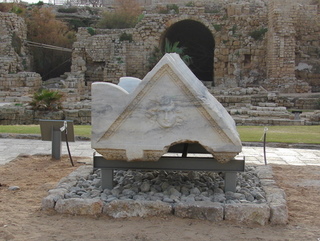A one-of-a-kind archaeological exhibition has opened in the port of Caesarea: for the first time, the general public will be able to see a unique 1,700-year-old sarcophagus (coffin) lid, one of the most impressive discovered in Caesarea

A one-of-a-kind archaeological exhibition has opened in the port of Caesarea: for the first time, the general public will be able to see a unique 1,700-year-old sarcophagus lid, one of the most impressive discovered in Caesarea.
The lid, which weighs more than 4 tons, is decorated with medusa heads crowned with snakes and masks with sad and happy expressions. These were taken from the world of the ancient theater, where two types of plays were used: comedy and tragedy. The meaning of the word medusa in Greek is 'keeper'; Anyone who looked directly at the mythological Medusa immediately turned to stone. In ancient times, they used to create Medusa reliefs, among other things, on various tombs and shields, hoping that it would ward off the threat.
Burial in large stone coffins (sarcophagi) was common in the Mediterranean basin in the 5nd-2th centuries AD. This burial custom first existed among the pagans, and later was also adopted among the Jews, Christians and Samaritans. The word 'sarcophagus' originates from the Greek word 'sarcopagos', which means "meat eater". Sarcophagi have two parts: a rectangular box for placing the deceased and a lid. The sarcophagi were buried inside burial structures (mausoleum; plural: mausolea) or in carved burial caves. The cemeteries of the inhabitants of ancient Caesarea extended outside the built-up area.
The lid of the impressive coffin, which seems to have been used to bury one of Caesarea's richest men during the Roman period, is one of a variety of unique stone items that were uncovered in Caesarea in archaeological excavations and in other ways, some of which are now on display in a renewed display at the port of Caesarea. The items are living and tangible evidence of Caesarea's rich past life as a Roman, provincial, vibrant capital city.
The exhibition was curated by the Antiquities Authority, which, together with the Society to Open Caesarea and the Nature and Parks Authority, sees this exhibition as the first swallow for additional archaeological exhibitions that will be held in the Caesarea port complex, based on the many finds that the Antiquities Authority has uncovered at the site over the years. The exhibition was curated by Ayelet Grover from the Antiquities Authority, designer and architect - Beaz Kidar, Teller-Kidar architects office.
Another unique find in the new display is an item that was part of a large and magnificent building, on which appears a dedicatory inscription - apparently of a woman named Cleopatra. It seems that she and her son or daughter belonged to a local noble family that donated the building to Colonia Caesarea.
Also, there is a sarcophagus on display on which an inscription appears, and it says that the husband - Eliphis, dedicates the sarcophagus to his beloved wife Manophila. The inscription also states that 'no one is immortal and such is life..'
The inscriptions are a rich source of information for understanding the history of Caesarea during the Roman and Byzantine periods. From it, you can learn about public life in the city; on its institutions, on political and personal connections; And about the residents of the city - their names, professions and beliefs.

2 תגובות
The inscription that appears regarding the lack of human immortality is quite typical of inscriptions on sarcophagi, both Greek and Latin. Inscriptions of Jewish graves from the ancient era, in Judea as well as in the Helleno-Roman diaspora, indicate this point. The reason for this is the desire to deal with the central and essential question in human life - why does life end. The lack of a satisfactory answer to this question actually gave rise to the ancient religions and beliefs.
Around the pier and the coal ships in Caesarea there are huge companies of jellyfish.
I feel sorry for the worker who will fall into the water there